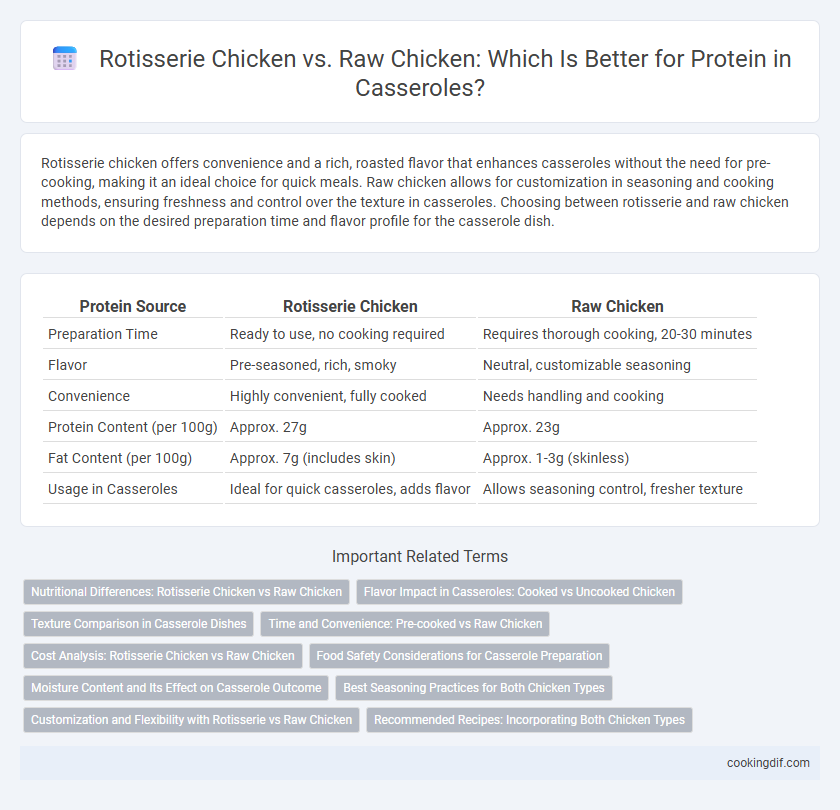Rotisserie chicken offers convenience and a rich, roasted flavor that enhances casseroles without the need for pre-cooking, making it an ideal choice for quick meals. Raw chicken allows for customization in seasoning and cooking methods, ensuring freshness and control over the texture in casseroles. Choosing between rotisserie and raw chicken depends on the desired preparation time and flavor profile for the casserole dish.
Table of Comparison
| Protein Source | Rotisserie Chicken | Raw Chicken |
|---|---|---|
| Preparation Time | Ready to use, no cooking required | Requires thorough cooking, 20-30 minutes |
| Flavor | Pre-seasoned, rich, smoky | Neutral, customizable seasoning |
| Convenience | Highly convenient, fully cooked | Needs handling and cooking |
| Protein Content (per 100g) | Approx. 27g | Approx. 23g |
| Fat Content (per 100g) | Approx. 7g (includes skin) | Approx. 1-3g (skinless) |
| Usage in Casseroles | Ideal for quick casseroles, adds flavor | Allows seasoning control, fresher texture |
Nutritional Differences: Rotisserie Chicken vs Raw Chicken
Rotisserie chicken provides a convenient, fully cooked protein option for casseroles, often higher in sodium due to seasoning and marinades, while raw chicken allows control over seasoning and moisture content. Nutritionally, rotisserie chicken tends to have slightly more fat and calories, especially from skin and added oils, compared to raw chicken, which is leaner and lower in calories when skinless. For casseroles, choosing raw chicken can result in a fresher flavor and healthier meal by reducing sodium and fat intake.
Flavor Impact in Casseroles: Cooked vs Uncooked Chicken
Rotisserie chicken brings a rich, seasoned flavor and tender texture to casseroles, enhancing overall taste without additional cooking time. Raw chicken absorbs casserole flavors during baking, resulting in a fresher but less intense chicken taste that varies based on seasoning and cooking method. Using rotisserie chicken intensifies savory depth, while raw chicken offers flexibility to customize seasoning profiles directly in the dish.
Texture Comparison in Casserole Dishes
Rotisserie chicken offers a tender, juicy texture that blends seamlessly into casserole dishes, providing a richer mouthfeel and enhanced flavor depth compared to raw chicken. Raw chicken requires careful cooking to achieve optimal tenderness, often resulting in a firmer, less consistent texture if overcooked or undercooked within the casserole. The pre-cooked nature of rotisserie chicken reduces the risk of dryness and maintains moistness, making it a preferred protein choice for casseroles seeking a balanced, satisfying texture profile.
Time and Convenience: Pre-cooked vs Raw Chicken
Using rotisserie chicken for casseroles significantly reduces cooking time since the meat is already cooked and only needs to be heated through, offering maximum convenience for quick meal preparation. Raw chicken requires thorough cooking within the casserole, extending baking time and demanding careful handling to ensure food safety. Choosing rotisserie chicken streamlines the process, making it ideal for busy households seeking both speed and ease without sacrificing protein quality.
Cost Analysis: Rotisserie Chicken vs Raw Chicken
Rotisserie chicken offers convenience and time savings but comes at a higher price per pound compared to raw chicken, which is more cost-effective for bulk casserole preparation. Raw chicken allows for greater control over portion sizes and seasoning, translating to lower overall expenses when preparing multiple servings. Considering cost analysis, raw chicken provides better value for casseroles, especially when budget constraints are a priority.
Food Safety Considerations for Casserole Preparation
Rotisserie chicken offers a convenient cooked protein option for casseroles, reducing the risk of undercooking that can occur with raw chicken. Using raw chicken requires careful handling, including avoiding cross-contamination and ensuring the casserole reaches an internal temperature of 165degF (74degC) for safe consumption. Proper food safety practices, such as thorough cooking and hygiene, are critical to prevent foodborne illnesses when incorporating chicken into casseroles.
Moisture Content and Its Effect on Casserole Outcome
Rotisserie chicken offers higher moisture content compared to raw chicken, resulting in a juicier and more flavorful casserole. Raw chicken tends to release more liquid during cooking, which can dilute sauces and affect texture negatively. Using rotisserie chicken minimizes moisture loss and enhances the overall richness and tenderness of the casserole.
Best Seasoning Practices for Both Chicken Types
Rotisserie chicken enhances casseroles with its seasoned, juicy texture, requiring minimal extra seasoning such as garlic powder, smoked paprika, and fresh herbs to complement its savory flavor. Raw chicken benefits from marination using a blend of olive oil, lemon juice, salt, pepper, and thyme to tenderize and infuse the meat with robust taste before baking. Both protein types achieve optimal casserole flavor by balancing seasoning intensity to harmonize with vegetables, cheese, and sauce components without overpowering the dish.
Customization and Flexibility with Rotisserie vs Raw Chicken
Rotisserie chicken offers immediate convenience and pre-seasoned flavor, allowing for quick casserole assembly and easy customization with various spices or sauces. Raw chicken provides maximum flexibility, enabling control over cooking methods, seasoning intensity, and texture to suit specific recipe requirements. Choosing between rotisserie and raw chicken depends on balancing time efficiency against personalized flavor and texture preferences in casserole preparation.
Recommended Recipes: Incorporating Both Chicken Types
Incorporating rotisserie chicken into casseroles offers convenience and rich flavor, making it ideal for quick, savory dishes like creamy chicken and rice bake. Raw chicken allows for customization of seasoning and texture, perfect for recipes requiring slow cooking such as classic chicken and vegetable casserole. Combining both types in recipes balances ease and freshness, enhancing protein variety while maintaining optimal taste and nutrition.
Rotisserie chicken vs Raw chicken for casserole protein Infographic

 cookingdif.com
cookingdif.com